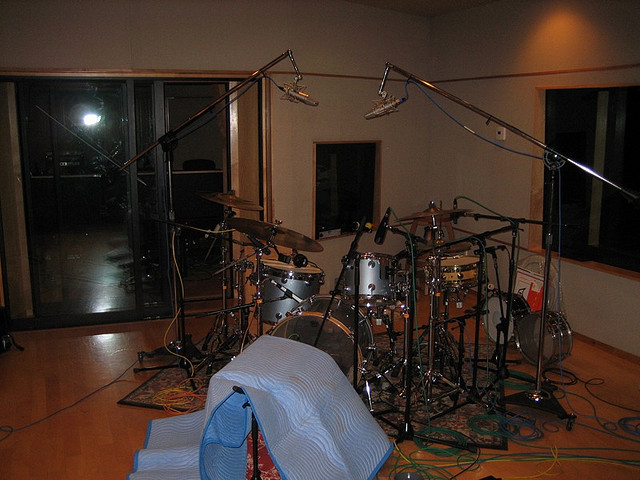overhead microphone on:
[Wikipedia]
[Google]
[Amazon]
 Overhead microphones are those used in
Overhead microphones are those used in
 Overhead microphones are those used in
Overhead microphones are those used in sound recording
Sound recording and reproduction is the electrical, Mechanical system, mechanical, electronic, or digital inscription and re-creation of sound waves, such as spoken voice, singing, instrumental music, or sound effects. The two main classes of ...
and live sound reproduction to pick up ambient sounds, transients and the overall blend of instruments. They are used in drum recording to achieve a stereo image of the full drum kit
A drum kit or drum set (also known as a trap set, or simply drums in popular music and jazz contexts) is a collection of drums, cymbals, and sometimes other Percussion instrument, auxiliary percussion instruments set up to be played by one p ...
, as well as orchestral recording to create a balanced stereo recording of full orchestra
An orchestra (; ) is a large instrumental ensemble typical of classical music, which combines instruments from different families. There are typically four main sections of instruments:
* String instruments, such as the violin, viola, cello, ...
s.
Overhead positioning
There are multiple arrangements for drum overheads, which are often based on personal preference of the musician,engineer
Engineers, as practitioners of engineering, are professionals who Invention, invent, design, build, maintain and test machines, complex systems, structures, gadgets and materials. They aim to fulfill functional objectives and requirements while ...
, or producer. These include "A-B" spaced pairs (where two directional microphones are suspended above the left and right clusters of cymbals), "X-Y" coincident pair
Stereophonic sound, commonly shortened to stereo, is a method of sound reproduction that recreates a multi-directional, 3-dimensional audible perspective. This is usually achieved by using two independent audio channels through a configurat ...
s, where the two directional microphones are centred on the drum kit with their capsule are very close without touching, and angled across each other at 90°. Coincident placement give a wider stereo image than spaced pairs, and some engineers prefer it for this reason.
Other drum overhead positions include the Recorderman Technique (where the distance between both microphones and the snare drum
The snare drum (or side drum) is a percussion instrument that produces a sharp staccato sound when the head is struck with a drum stick, due to the use of a series of stiff wires held under tension against the lower skin. Snare drums are often u ...
is equal, as is the distance between both microphones and the bass drum
The bass drum is a large drum that produces a note of low definite or indefinite pitch. The instrument is typically cylindrical, with the drum's diameter usually greater than its depth, with a struck head at both ends of the cylinder. The head ...
) and the Glyn Johns method (where one "overhead" is placed to the drummer's right, aiming across the floor tom
A floor tom or low tom is a double-headed tom-tom drum which usually stands on the floor on three legs. However, they can also be attached to a cymbal stand with a drum clamp, or supported by a rim mount. It is a cylindrical drum without snare ...
to the centre of the kit).
In orchestral recordings, particularly those for film score recordings, the Decca tree
The Decca Tree is a spaced microphone array most commonly used for orchestral recording. It was originally developed as a type of stereo A–B recording method adding a center fill. The technique was developed in the early 1950s and first commerc ...
is often used.
Footnotes
Sources
* * * * * * {{refend Sound recording Microphones